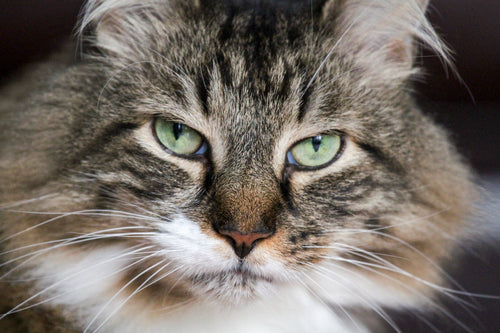Chronic kidney disease is mainly a problem in older cats. Important organs, kidneys remove waste from the bloodstream daily, regulate the levels of certain essential minerals, conserve water, and produce urine. When they are affected by aging or otherwise damaged, they lose those abilities. Unfortunately, it can take months, even years, before you notice your cat may be in trouble because the kidneys must be at least two-thirds dysfunctional before most clinical signs are evident. In addition, a lot of the symptoms are easy to dismiss as normal aging.
What Are the Symptoms?
In the initial stages of failure, the kidneys cope by producing a larger amount of dilute urine to remove waste. To compensate for the increased water loss from their bodies, cats typically drink more, and because of that, they often eat less. Aside from those two behavior changes, the most common symptoms are weight loss, poor hair quality, halitosis (bad breath), mouth ulcers, lethargy, and depression.
What Causes this?
It can be hard to figure out why the kidneys are failing, but the most common culprits are:
- Pyelonephritis (bacterial kidney infection)
- Glomerulonephritis (inflammation and damage to the kidney's filtration membrane)
- Cancer—various tumors of the kidney, most commonly lymphosarcoma
- Viral infections such as feline leukemia virus (FeLV) or feline infectious peritonitis virus (FIP)
- Kidney stones or ureteral stones
- Congenital malformations of the kidneys such as polycystic kidney disease in long-haired cats
How Is the Disease Diagnosed?
Usually your veterinarian will do blood tests to look for increased levels of blood urea nitrogen (BUN) and creatinine, plus a urinalysis to evaluate the concentration of urine and presence of protein (another sign of kidney disease). For a long time it’s been frustrating because the rises in BUN and creatinine don’t show up until the kidneys have lost a lot of function. But there’s a newly developed test for a third blood indicator, increased levels of symmetric dimethylarginine (SDMA), that appears before the others. So now, ideally, using multiple tests, treatment can get started at an earlier stage in the disease.
To determine how severe the kidney disease is, your veterinarian will use the International Renal Interest Society (IRIS) staging system based on serum creatinine levels, with sub-staging based on the presence of protein in the urine and your cat’s blood pressure. This will provide a better idea of your pet’s prognosis and how to proceed with treatment and monitor progress.
What Treatments Are Available?
The majority of cats improve with diet modification, supplementation, and one or two other treatments. There are a number of therapies aimed at resolving specific abnormalities and dehydration. Reducing blood phosphorus, for example, can have a major effect on improving your cat's well-being and slowing disease progression.
Often a diet low in protein and phosphorus is recommended to help cut down on waste products in the bloodstream. You can prepare it at home or buy it as prescription food for advanced cases. On top of that, oral phosphate binders like aluminum hydroxide and chitosan may reduce the amount of phosphorus absorbed through the gut wall. When the failing kidneys are unable to concentrate the urine, water-soluble vitamins such as B and C can be lost and some cats may benefit from daily supplementation.
Shine Pet Food is available to consult with your veterinarian if you are interested in a special dietary formula for your cat.





